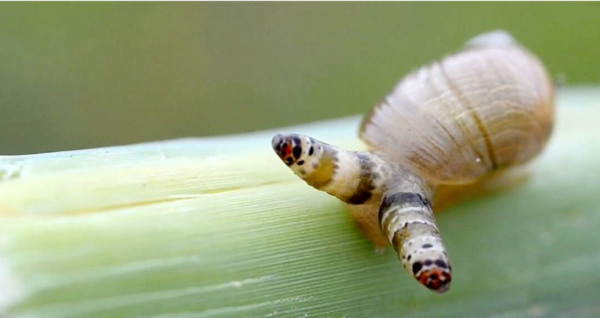As the holiday season is well underway, many of us will have already booked our accommodation in whichever country, city or town we have chosen to visit. There are a lot of options these days, and they all cater to a wide variety of visitors, who will have different tastes, requirements and budgets. A hotel, motel, villa, hostel, or AirBnB – no matter where you’re staying, the rules are always the same: take care of the furnishings, don’t steal the towels, and treat the premises with the same respect as you would your own house.

Bearing these sacred rules in mind, I draw your attention to a certain flatworm called the Leucochloridium paradoxum (also known as the ‘green-banded broodsac’, if your Latin is a little rusty). This tricky customer, often found in the forests of Europe and North America, should not be welcomed into any salubrious establishment it happens to wander into. Why? Because this particular worm is a parasite and it doesn’t treat its hosts hospitably.
Hiding in the vegetation most often frequented by their favourite slithering abode, snails, L. paradoxum eggs await the approach of their unsuspecting prey. Having been consumed by the snail, the parasitic larva travels to its digestive system. Once there, the larva metamorphoses into a ‘sporocyst’ – look them up online; they are truly sinister in appearance – and begins to assume control of the snail’s body. After effectively turning the snail into a mindless zombie at the parasite’s command, L. paradoxum begins turning the unfortunate snail’s body into a fantastic, pulsating display of rippling colours. Slithering to the high surface of a plant, resembling the floor of a ‘70’s discotheque, the snail now perfectly resembles a large caterpillar or grub; the very meal of choice for any birds in the area. These, it turns out, are the parasite’s real target.
This is the parasite’s game-plan: the snail, turned into a psychedelic puppet, displays itself proudly to the avian threats surrounding it and sooner or later is consumed. Once inside the stomach of a bird, the parasite’s journey it almost complete: it lays its eggs, which are promptly delivered vertically downward by the bird and then lay in waiting for the next unfortunate snail to innocently cross its path.
A far cry from the harmonious natural phenomenon you might hear about narrated by Morgan Freeman over footage of marching penguins, L. paradoxum is a striking example of the more cunning aspects of nature. The mind-control and colourful pyrotechnics that it displays in its hosts are called ‘aggressive mimicry’ by biologists – the parasite effectively takes on the character of its desired host’s favourite food in order to infiltrate it. This is quite different to similar tricks in the animal world, where it is far more common for a predator to assume the form of its prey’s food and then eat the prey directly.
The whole life-cycle of the L. paradoxum is a highly fascinating one, and there exist many videos online which allow us to glimpse the surreal effect that the parasite can produce in its targets (any video with a title like ‘zombie snails’ has surely got to be worth investigating?). In ancient Greece, hospitality – ξενία (xenia) – was one of the highest virtues and Zeus, the king of the gods, was its patron. The Greeks believed that anyone they met could be a god disguised as a mortal, so they endeavoured to treat strangers with respect and generosity on all occasions. Evidently the L. paradoxum never got the memo, but at least we in the human world have learned to treat our surroundings, our dwellings and the people we meet with a little more respect.







